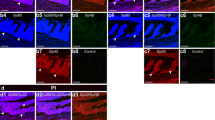Abstract.
Luteinizing hormone (LH) immunoreactivity was detected in the lung and stomach of chick embryos by the immunoperoxidase staining technique using specific antiserum to chicken LH. Immunoreactive LH (ir-LH) cells first appeared in the primordial cells of the epithelial layer of lung bud and foregut as well as of Rathke’s pouch in the 3-day-old embryo, Hamburger and Hamilton stage 21. Ir-LH cells increased in number with advancing age of embryos in the lung, stomach, and pituitary gland. In the lung of 7-day-old embryos, stage 31, the ir-LH cells were distributed in the epithelium of primary, secondary, and tertiary bronchi, and their shapes were pseudostratified columnar, simple columnar, and simple cuboidal, depending on their sites in the intrapulmonary airway. Ir-LH cells were more numerous in the median part than in the lateral part of the lung, and the population in the epithelial layer of entobronchi of the secondary bronchi was 4 times higher than that in ectobronchi and laterobronchi of the secondary bronchi and in the primary bronchi. The immunoreactive products were found, either in the entire cell or in the apical part, facing the lumina of bronchi. In the stomach, ir-LH cells were found in the epithelial layer of gastric glands. No ir-LH cells were observed in interstitial regions, which consisted of mesenchymal cells and blood vessels, in the lung and stomach tissues. With advancing age, ir-LH cells changed their shapes to flat or squamous, coincident with the formation of parabronchi. Other pituitary hormones were not observed immunohistochemically in either the lung or stomach before hatching. Preabsorption of the antiserum against avian LH with the purified chicken LH or the extract of pituitaries from 10-day-old embryos completely destroyed the immunoreactivity to the cells in the lung and the pituitary. A single band of the immunoreaction products, whose molecular weight was around 25 K daltons, was shown by the immunostaining of nitrocellulose membrane transblotted after sodium dodecylsulphate-polyacrylamide gel electrophoresis of the purified pituitary LH, extracts of pituitaries from 10-day-old embryos, and the extracts of lungs from 7-, 10-, and 14-day-old chick embryos. These results demonstrated that ir-LH cells are present in extrapituitary tissues, and may play an important role during the development of chick embryonic lung and stomach.
Similar content being viewed by others
Author information
Authors and Affiliations
Additional information
Received: 16 February 1995 / Accepted: 15 August 1995
Rights and permissions
About this article
Cite this article
Shirasawa, N., Shiino, M., Shimizu, Y. et al. Immunoreactive luteinizing hormone (ir-LH) cells in the lung and stomach of chick embryos. Cell Tissue Res 283, 19–27 (1995). https://doi.org/10.1007/s004410050508
Issue Date:
DOI: https://doi.org/10.1007/s004410050508




